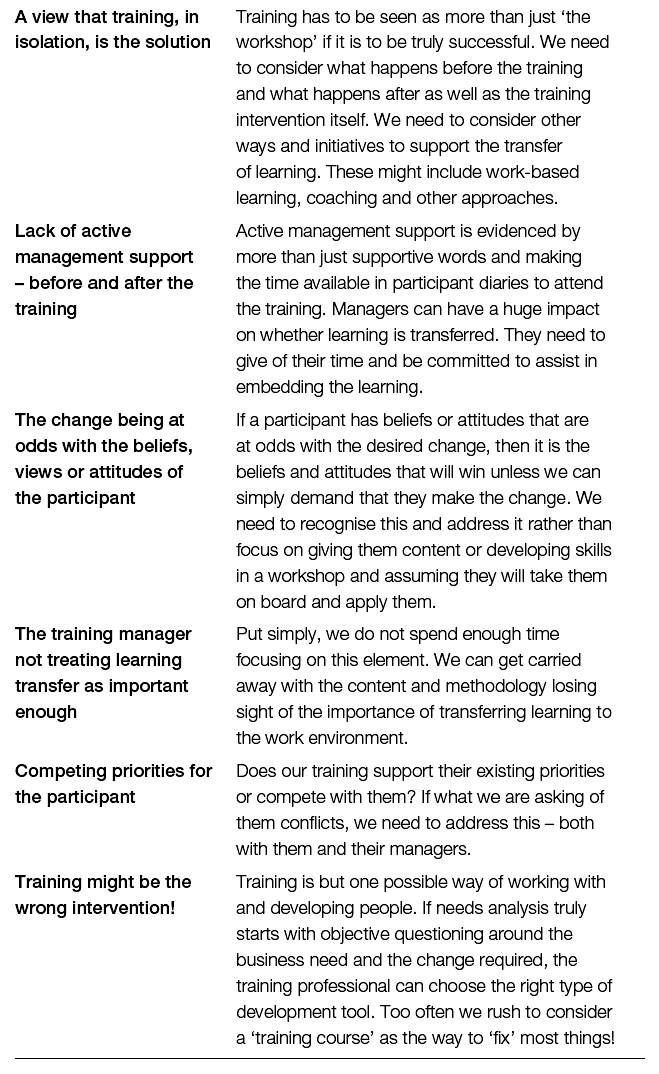How to encourage participants to take action
How many times have you attended, or even delivered, a training session where getting a participant to take action is limited to a few snatched minutes of reflection and sharing at the end of the workshop? Most workshops even have concise sheets of paper to give out that ask searching questions such as ‘What will you do differently as a result of this training?’ Are you guilty of beginning and ending your contribution to a participant acting on your training by limiting it to the final session of a workshop?
Where business training requires some sort of change in behaviour or development of new skills by participants then this ‘leaving it to the last minute’ approach will not work. It definitely will not work. But we are all guilty of fooling ourselves into thinking that it will.
The root cause of failure to transfer and apply the learning gained in business training is the fact that most business training simply underplays this aspect. We do not pay enough attention to it either in the design or delivery. But it is often in the transfer of learning to the work environment where we can add most value to the business. In fact, we could go so far as to question whether a training function should be funded if it cannot influence transfer of learning.
We are going to look at the issues in gaining commitment in the first instance (as opposed to the relatively passive activity of action planning) and on what you can do in your training to ensure that participants commit to applying that learning in the workplace.
Issues preventing the application of learning
A number of situations contribute to workshop learning being taken no further than the classroom. Some of these are tactical in their nature whereas others are systemic and require a more strategic approach if we are to avoid them.
The following table outlines some of the issues in no particular order:

If these are some of the issues, what should our priorities be in design to maximise the chance of learning from a business training session being transferred into the workplace?
What to do to gain commitment to action
Let us assume that you have carried out a robust and objective needs analysis and that you have defined training as the best way to deliver against the business need. Let us further assume that this needs analysis has drilled down into the real requirement and defined the specific actions or change required in the work environment to deliver the business objectives for the training. You can help ensure that the training results in learning being transferred to the workplace by focusing on a few key things:
- Raise awareness and develop responsibility. Both in design and during delivery we should be helping participants raise their awareness around the benefits of change, the practical constraints and barriers to change, their own beliefs and attitudes and how these will affect the transfer of learning and its practical application. Reinforce the ‘What’s in it for me?’ for them – the benefit to them that will engage motivation to take action. Help them understand the choices they have available and the implications of these choices – people are often more committed to something if they feel they had a choice and have made a reasoned decision.
- Focus on gaining active support from line managers. Discuss the training with line managers before it occurs. Seek their views, explore the options and help make the link between the training and the benefits to the participant, the line manager and the business. Brief them on their role and gain commitment for their time to assist in transferring the learning. Help them understand what they need to do before the training and after the training. Examples of actions that might be relevant here include:
- having a discussion with participants to elicit their objectives and outcomes from the training, helping them understand how it links to their role and the benefits, showing support for the training;
- meeting participants after the event and reviewing the experience, discussing their priorities and agreeing on the internal support required;
- ongoing coaching of participants to help support and encourage transfer of the learning, discussing barriers and working together to overcome them.
- Plan follow-up after the training event. What can you do as a training professional to help keep the learning alive and ensure that it is applied to deliver the required results? You have a part to play in reviewing the training with participants, understanding what is happening and what is not happening as a result of the training and planning how to move forward. This is also part of the continuous improvement process mentioned earlier. Examples of actions that might be relevant here include:
- seeking anecdotes of success to share with other participants to build confidence and then sharing these with everybody involved as quickly as possible to build motivation;
- talking with participants to review their experience of applying the learning and supporting them with any issues they have;
- challenging limiting beliefs and assumptions that you hear from participants which may be barriers to success.
As with many elements of business training, success with this aspect of gaining participant commitment to action and seeing the learning transferred into the work environment cannot be seen in isolation. The ideas above point to a clear link between any action planning during a business training and the role of follow-up and evaluation of the programme, which is discussed later.
What we have often seen is that too little time is given to action planning during the business training. It is left to a few minutes at the end of the session and so does not have the method or the emphasis to be fully effective.
Practical application
Whilst we have discussed some of the elements that you can take account of and incorporate into your training design, there are also lots of practical things that you can do within the context of the training delivery itself:
- Take enough time to ‘build the ‘Why?’ for the participant. This is mentioned in other parts of this book because it is central to great training. In the context of gaining commitment to take action, participants need to be clear on why this is so important for them. Moving into the content before building ‘the Why?’ reduces the chance of engagement and, therefore, of participants taking action after the training.
- Surface participant beliefs and views. No amount of training will lead to change if the participant has beliefs or views that are contrary or work against applying what you are teaching. Beliefs that limit change or views that are contrary to what is needed for applying the learning need to be surfaced – partly to raise participant awareness that this is an issue and partly so that they can be discussed and addressed.
- Future pace. One technique is to have participants write a letter set at a suitable date in the future outlining what they did to secure the result they achieved (relevant to the learning content of the business training). This can include the barriers they encountered, what they did to overcome them and so on. The idea of ‘future pacing’ works at an unconscious level on the basis that the exercise assumes that success has been achieved and that any barriers on the way had been identified and overcome.
- Visualisation of success. This is a similar technique. Simply ask the group to imagine a time in the future when they had achieved what they had set out to (based on the training). Ask them to really connect with the benefits they experienced. Get them to connect with what they are seeing, hearing and feeling. Ask them to make this image as vivid as possible.
Variants of this include:
- Writing out key commitments for a certain timeframe and putting these in an envelope for the trainer to post to them at some agreed time in the future.
- A physical exercise where participants are encouraged to first think about the specific actions they need to take towards achieving their desired goal, in order, and then stand up and walk forward step by step ‘into the future’, seeing themselves achieving each of the actions and noticing how it makes them feel. This technique works particularly well for kinaesthetic learners and really helps them internalise the commitment to action that they make.
- Setting up buddy groups. It often helps with accountability if you can pair participants at the end of a business training event so that they can meet up at various intervals. These meetings can be used to discuss progress, actions taken, problems encountered and coaching each other to move forward. Sometimes, the simple knowledge that you have a meeting coming up where you will need to talk about what you have done can make a difference between taking action or putting it off.
- Make the most of the ‘action planning’ section. Plan this aspect thoroughly. Consider the questions you will ask to raise awareness and promote individual accountability. For example, studies show that the success of achieving goals is increased if, at the same time as defining a SMART goal, you consider the barriers that could stop you achieving them and what you will do to overcome them.
Some useful questions you can ask include:- ‘On a scale of 1–10, how sure are you that you will take the action you have committed to?’ If the answer is 7 or less, ask a follow-up: ‘What would make it a 10?’
- ‘What, specifically, are the barriers that could prevent you taking this action?’ And the obvious follow-up: ‘What will you do to prevent these holding you back?’
- ‘What support do you need and who from?’ And the follow-up: ‘What will you do to secure this support?’
- ‘What elements of taking action are you fully in control of?’
Summary
As with a lot of aspects of training, we have seen that the action planning cannot be seen in isolation if we want to maximise the chance of successful learning transfer and application.
- There are a lot of potential barriers to action – some systemic, some human and individual. Considering these as part of your design and planning to address them is critical.
- Of all the barriers that exist, the role of an individual’s beliefs, assumptions and views can have significant impact. Business training needs to surface and address this if it is an issue.
- Raising awareness and responsibility are key if an individual is to take action. This includes helping them understand the ‘What’s in it for me?’ and the barriers that they need to overcome, as well as support that they might need, in order to transfer the learning into the work environment.
- Line management support is often a big factor in whether learning is applied – meet with managers, help them understand their role and how to support the transfer of learning.
- Make the most of action planning in business training. Do not leave it until 10 minutes at the end of the session but build in questions and interventions (such as buddying or future pacing) to maximise the motivation of participants to take the action required.

